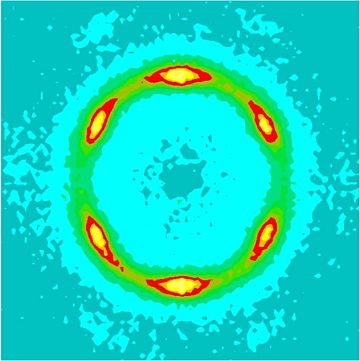Neutron scattering techniques
Small-angle neutron scattering (SANS)

In neutron scattering experiments, instruments count the scattered neutrons as a function of wave vector Q, which depends on the scattering angle θ and wavelength λ. For elastic scattering – i.e., when scattered neutrons have identical energy to the incident neutrons – this corresponds to measuring with diffractometers the momentum change. Information about the spatial distribution of nuclei in the sample of interest can then be obtained in systems ranging in size and complexity from small unit-cell crystals, through disordered systems such as glasses and liquids, to “large-scale” structures such as surfactant aggregates and polymers. Small-angle neutron scattering (SANS) is an experimental technique that uses elastic neutron scattering at small scattering angles (<10o) to investigate the structure over length scales of 1-100 nm.
During a SANS experiment a beam of neutrons is directed at a sample, which can be an aquoues solution, a solid, a powder, or a crystal. Because surfactants form aggregates (micelles) in solution, as surfactant scientists we are often interested in studying aqueous samples. The neutrons are elastically scattered by nuclear interaction with the nuclei or interaction with the magnetic moment of unpaired electrons. Because neutrons interact with nuclei and interaction depends on isotope; isotopes like hydrogen (1H) and deuterium (2D) scatter differently to each other. This property can be exploited to create contrast variation in samples. For example, this is routinely applied in microemulsion droplets where different structural regions can be highlighted by selectively varying the composition of 1H and 2D in the surfactant, oil or aqueous phase.
Neutron reflection
Neutron reflectometry is a technique for measuring the structure of thin films and can provide valuable information over a wide variety of scientific and technological applications. This technique is used in materials science through to soft matter and bioscience, providing information on chemical aggregation, polymer and surfactant adsorption, structure of thin film magnetic systems, biological membranes, etc.

ki / ks = incident / scattered wave vectors, θ = scattering angle
The technique involves shining a highly collimated beam of neutrons onto a flat surface and measuring the intensity of reflected radiation as a function of angle or neutron wavelength, a simplified figure of this is shown right. The exact shape of the reflectivity profile provides detailed information about the structure of the surface, including the thickness, density, and roughness of any thin films layered on the substrate. Like all neutron scattering techniques, reflectometry is sensitive to contrast arising from different nuclei (as compared to electron density, which is measured in X-Ray scattering). This allows the technique to differentiate between various isotopes of elements. Neutron reflectometry measures the neutron scattering length density (SLD) and can be used to accurately calculate material density if the atomic composition is known.